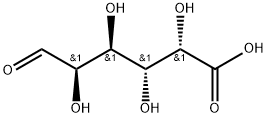POLYGALACTURONIC ACID
- CAS NO.:25990-10-7
- Empirical Formula: C6H10O7
- Molecular Weight: 194.14
- MDL number: MFCD00131972
- EINECS: 211-682-6
- Update Date: 2024-08-28 13:53:27

What is POLYGALACTURONIC ACID?
The Uses of POLYGALACTURONIC ACID
Polygalacturonic Acid is found in ripe fruits and some vegetables and is a degradation product of pectin in plants.
The Uses of POLYGALACTURONIC ACID
Polygalacturonic acid may be used to identify, differentiate and characterize plant cell wall degrading polygalacturonase(s) from fungi.
What are the applications of Application
Polygalacturonic acid is a reagent which sequesters metal ions and produces gels that can be used for the production of biomolecules
Definition
ChEBI: D-galactopyranuronic acid is the pyranose form of D-galacturonic acid It is a conjugate acid of a D-galactopyranuronate.
General Description
Polygalacturonic acid is composed of galacturonic acid unit arranged as a long polymer chain. Methyl esters of polygalacturonic acid forms pectin.
Biochem/physiol Actions
In land plants, polygalacturonic acids are major components of cell wall polysaccharides (pectins). Bound polygalacturonase-inhibiting peptides (PGIP) protect pectin from degradation by fungal polygalacturonases.
Properties of POLYGALACTURONIC ACID
| Melting point: | 60~61℃ |
| storage temp. | Refrigerator |
| solubility | aqueous NaOH: 1%, clear to hazy |
| form | Solid |
| color | Pale Beige |
| Water Solubility | Soluble in water. |
| Sensitive | Hygroscopic |
| EPA Substance Registry System | Galacturonic acid, homopolymer (25990-10-7) |
Safety information for POLYGALACTURONIC ACID
| Signal word | Warning |
| Pictogram(s) |
 Exclamation Mark Irritant GHS07 |
| GHS Hazard Statements |
H315:Skin corrosion/irritation H319:Serious eye damage/eye irritation H335:Specific target organ toxicity, single exposure;Respiratory tract irritation |
| Precautionary Statement Codes |
P261:Avoid breathing dust/fume/gas/mist/vapours/spray. P271:Use only outdoors or in a well-ventilated area. P280:Wear protective gloves/protective clothing/eye protection/face protection. |
Computed Descriptors for POLYGALACTURONIC ACID
New Products
4-AMINO-TETRAHYDRO-PYRAN-4-CARBOXYLIC ACID HCL 4-(Dimethylamino)tetrahydro-2H-pyran-4-carbonitrile 4-Aminotetrahydropyran-4-carbonitrile Hydrochloride (R)-3-Aminobutanenitrile Hydrochloride 3-((Dimethylamino)methyl)-5-methylhexan-2-one oxalate 1,4-Dioxa-8-azaspiro[4.5]decane 5-Bromo-2-nitropyridine Nimesulide BP Aceclofenac IP/BP/EP Diclofenac Sodium IP/BP/EP/USP Mefenamic Acid IP/BP/EP/USP Ornidazole IP Diclofenac Potassium THOMAIND PAPER PH 2.0 TO 4.5 1 BOX BUFFER CAPSULE PH 9.2 - 10 CAP SODIUM CHLORIDE 0.1N CVS ALLOXAN MONOHYDRATE 98% PLATINUM 0.5% ON 3 MM ALUMINA PELLETS (TYPE 73) LITHIUM AAS SOLUTION 2-Bromo-1-(bromomethyl)-3-chloro-5-nitrobenzene 2-Bromo-3-nitroaniline N-(3-Hydroxypropyl)-N-methylacetamide 3-Bromo-6-chloropyridazine 4-ethyl-3-nitrobenzoic acidRelated products of tetrahydrofuran








You may like
-
 Polygalacturonic acid CAS 25990-10-7View Details
Polygalacturonic acid CAS 25990-10-7View Details
25990-10-7 -
 1-Methyl-6-oxo-1,6-dihydropyridazine-3-carbonitrile 98%View Details
1-Methyl-6-oxo-1,6-dihydropyridazine-3-carbonitrile 98%View Details
99903-60-3 -
 1823368-42-8 98%View Details
1823368-42-8 98%View Details
1823368-42-8 -
 2-(3-(tert-butyl)phenoxy)-2-methylpropanoic acid 1307449-08-6 98%View Details
2-(3-(tert-butyl)phenoxy)-2-methylpropanoic acid 1307449-08-6 98%View Details
1307449-08-6 -
 Ethyl 3-(furan-2-yl)-3-hydroxypropanoate 25408-95-1 98%View Details
Ethyl 3-(furan-2-yl)-3-hydroxypropanoate 25408-95-1 98%View Details
25408-95-1 -
 2-Chloro-5-fluoro-1-methoxy-3-methylbenzene 98%View Details
2-Chloro-5-fluoro-1-methoxy-3-methylbenzene 98%View Details
1805639-70-6 -
 1784294-80-9 98%View Details
1784294-80-9 98%View Details
1784294-80-9 -
 Lithium ClavulanateView Details
Lithium ClavulanateView Details
61177-44-4